
Marc Trujillo
Painter Marc Trujillo, who paints airports, big box stores and the occasional bag of potato chips with Vermeer-like candor, is currently having two shows: one at the Bakersfield Museum of Art and another at the Winfield Gallery in Carmel. Working with banal material, Trujillo generates scenes that attempt walk a fine line between the ordinary and extraordinary. Carefully modulated and cannily observant, Trujillo’s canvases show us that the places we barely notice can be recast as scenes of unexpected grandeur.
John Seed Interviews Marc Trujillo
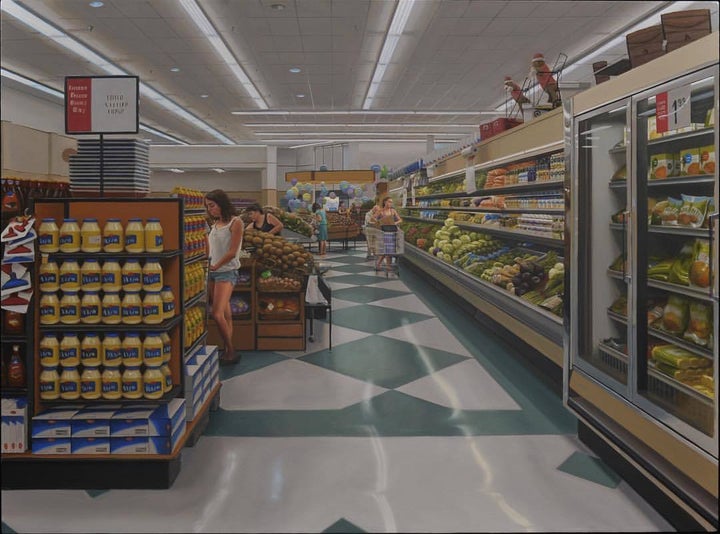
1644 Cloverfield Boulevard', 23" x 31," oil on polyester over panel
Marc, where did you grow up and how did your childhood shape you?
I'm from Albuquerque, New Mexico, it's big sky country like Montana and the land keeps you aware that you're a small figure in a vast landscape which makes sense to me as a worldview and manifests itself in the paintings in the way I tend to scale the figures, they're important but are held in check by scale. As a child, I only wanted to draw and read books, so my parents put me in gymnastics which gave me a good sense of discipline and I also realized that painting was something I could do my whole life, as opposed to gymnastics which has a short shelf-life.
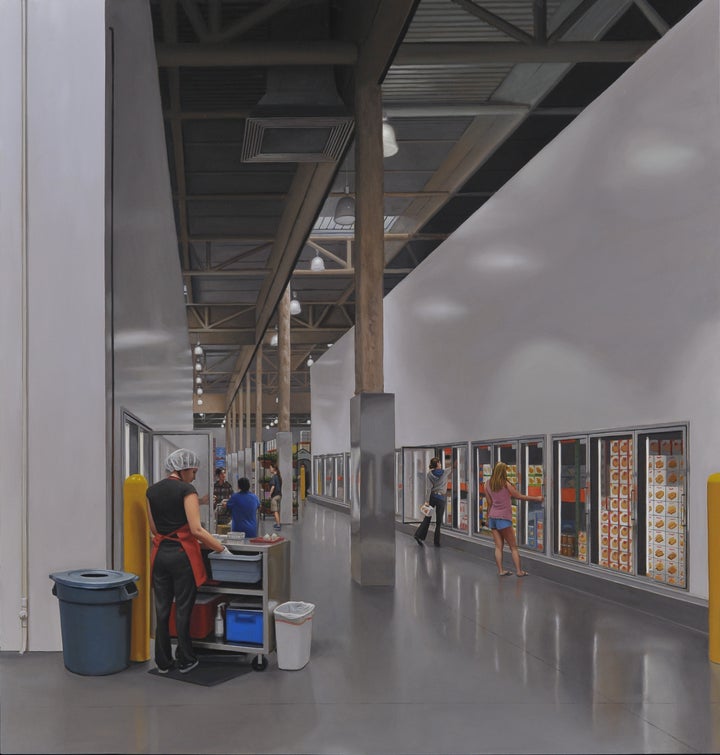
6333 Commerce Road, 24.75 x 23.5, oil on polyester over panel
How did your studies at Yale, and your interactions with Andrew Forge help you mature as an artist?
Graduate school is where you go to have the philosophical core you operate from thoroughly cross-examined. Andrew Forge would parse out distinctions that were fine enough to nudge and refine the way you thought. He defined 'Artiness' as 'when the aesthetic effect is a consequence of things known beforehand', for example.
William Bailey was also important to me as a model of making sure what you were doing was really painting. There are different forms and why something should be a painting as opposed to a song or novel or photograph should be a part of your intention or area of investigation from the outset. While a painting may show a place, for Bailey 'the painting is the place.’ A painting has an autonomous reality as a painting and Bailey's teaching and paintings both bear this out.

8810 Tampa Avenue, 26 x 33 inches, oil on aluminum 2015
You are known for painting subject matter that others might consider banal: when did you realize that ordinariness held a special attraction for you?
The chill of the void is alluring to me. These places that are nowhere and everywhere, big stretches of concrete and linoleum give me a chill that makes me want to paint them. Also, when a painting goes too low or too high in terms of subject matter it plays to easily into people's fantasy lives, and showing something that the viewer fantasizes about is narrative poison to me.
Joyce defined pornography that way: when you show the viewer something that they want to possess. I think he got this from Kant who said that the greatest experience you can have in front of a work of art is the "God-like moment', which is disinterested pleasure; the pleasure you get from the paintings is not because you want what they are showing you. The low temperature of my subject matter also helps keep the painting the thing, to go back to the point about 'the painting is the place.’ If I paint something like Mount Everest or the Grand Canyon then the painting reminds you of this greater experience outside of itself, like a postcard. On the other hand if I'm painting a gas station or Costco, then the painting has a chance at being more of an experience than you had when you were there.
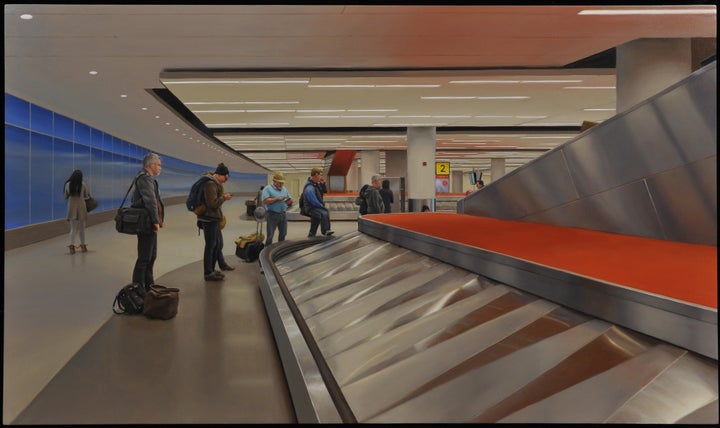
John F Kennedy International Airport, 16 x 27 inches, oil on panel, 2015
Tell me how the works of Jan Vermeer have informed and influenced you.
First of all by being part of what made me want to paint in the first place; my reaction to them came before my reflection about why they're so good. Then you go back and look at them as a painter instead of as a fan so that you can bring something back to you own work, Vermeer's paintings are superbly composed and balanced, the light in them is as important a character as anything in the painting, and his sense of scale is very refined.

View of Delft, 38 x 45.6 inches, oil on canvas, 1660-61
View of Delft is a pretty perfect painting, when you're standing in front of it, it's large enough to have some physical scale to it, but intimate enough that you don't notice the size of the painting before you see what Vermeer is showing you. View of Delft is about 38 inches high, so if I'm not sure how large to make a painting, then I'll make it 38 inches high by whatever width I need for the composition. I've made quite a few 38 inch high paintings.
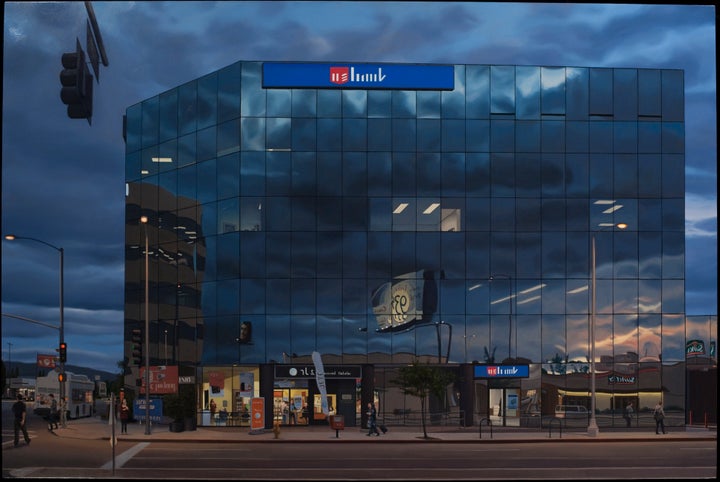
6350 Laurel Canyon, 40 x 60 inches
Tell me about one of the paintings you have on view in Bakersfield. How did it come about, and what kind of impact do you want it to have on viewers?
I think the show as a whole helps show how the work is made and am grateful to the curator, Rachel Magnus, since it was important to us to show how synthetic the paintings are- I make them like one frame movies, building the set (The vanishing point is the first thing on the painting), lighting it, and casting it. Making as thinking is vital to me. since I need to do a lot of drawing to more fully imaginatively own my subject as well as to distill my visual motive for making a painting of it, the muted narratives in the painting are all kept that way so that the viewer is the most important figure in the painting.
My area of investigation has come out of the work, rather than starting with a narrative and painting it, there are also cases filled with sketchbooks which I work in steadily, plein air paintings and studies from life: all of this is part of the food chain with the studio paintings at the top. It helps since some viewers might misunderstand the paintings as being 'photorealist'. Since scale is important, I hope people experience the work in person, to continue from the last question; the actual painting is the result and the test of everything that goes into it.
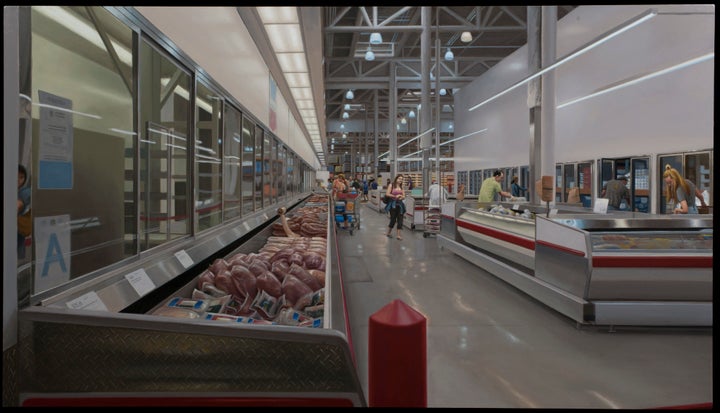
517 East 117th Street, 25 x 44 inches.
So, to answer your question by singling out a painting, 517 East 117th Street is 25 x 44 inches. My motive for painting this was the red carpet of meat that you get when you stand in this spot in Costco. This painting is shown along with the composition drawing for it and there's an iPad on the wall as well with various stages of the painting in progress. This preparatory work also determines the scale and we've grown too accustomed to the fluid scale that things we see digitally has: are you looking at it on your phone or is it being projected on a wall? People mostly look at things on screens, so both scale and tactility suffer, as well as the sense of light that I take a lot of pains to calibrate out of what photography gives you, which the fixed iris of the camera rolls back.
Is it fair to say that you are -- in your heart -- a very traditional painter who sees yourself as part of a long unbroken lineage?
Bringing the long, slow, patient way of looking and making to bear on the places we've made for ourselves that are hardly meant to be looked at at all is an important counterpoint of tradition and our contemporary world. In 'Tradition and the Individual Talent', T.S. Eliot couches a healthy relationship to tradition and that it needs to include the historical sense: 'This historical sense, which is a sense of the timeless as well as of the temporal and of the timeless and of the temporal together, is what makes a writer traditional.’
And it is at the same time what makes a writer most acutely conscious of his place in time, of his own contemporaneity.' Eliot also points up that tradition has to be earned and is not automatically inherited and opposes it to what people sometimes think of as tradition ' following the ways of the immediate generation before us in a blind or timid adherence to its successes.' So, yes would have been the short answer but the word tradition is mostly used in the sense of following and the criticality of it gets lost sometimes.
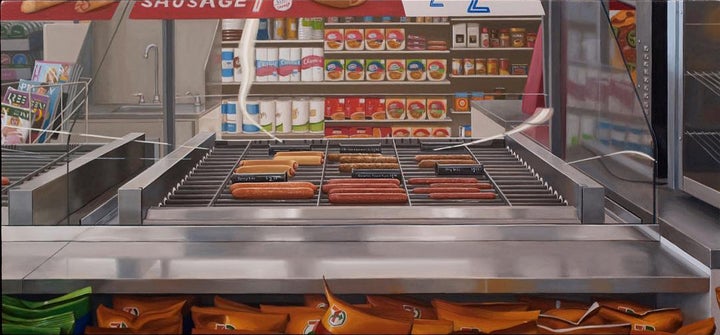
7950 Santa Monica Boulevard, 16 x 35 inches, oil on linen over panel
What are you interested in outside of painting?
The sister arts, literature, sculpture, music (I play guitar some and am the first name on the music credits for 'El Mariachi', Robert Rodriguez' first movie). Linda and I like to go hiking together and have a Rottweiler Ursa, who is a rescue dog.
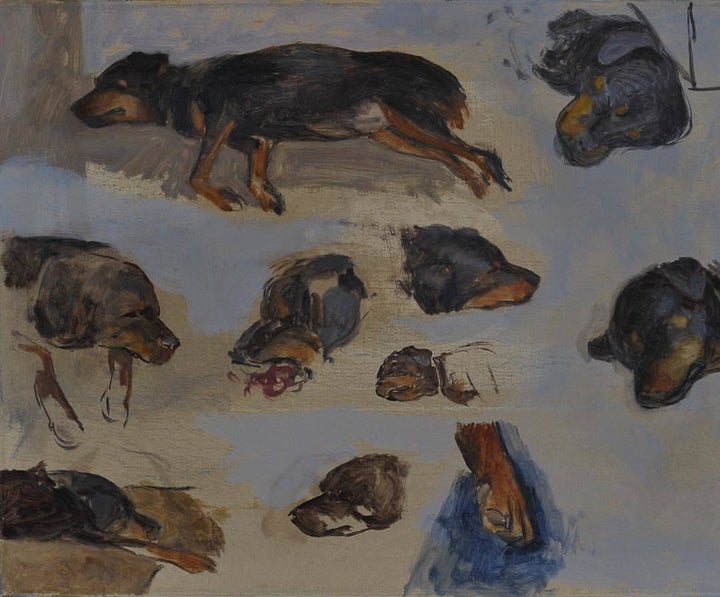
Oil sketches of Ursa
Exhibitions:
The Bakersfield Museum of Art
January 26, 2017 - May 7, 2017
Winfield Gallery, Carmel, CA
February 1 - 28, 2017
